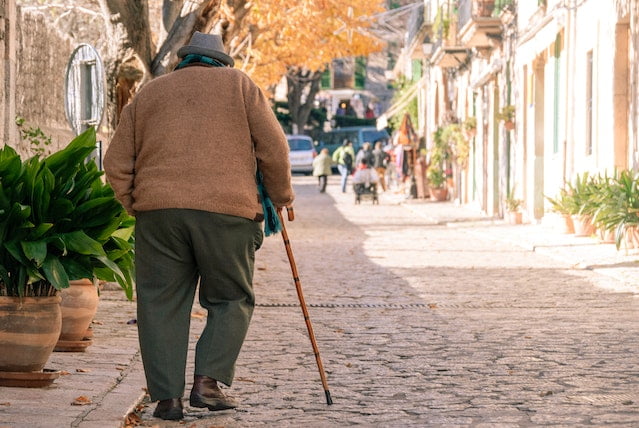Mobility issues have increased over the past decade possibly due to the lifestyle shift which started happening with the evolution of technology. People tend to spend more time sitting which results in issues like muscle stiffness or, in extreme cases, muscle atrophy. Furthermore, movement could also be restricted due to a disease state or a recent trauma. Whatever the cause may be, the subject requires mobility aids to ease the movement from one place to another. Let us understand what mobility aids actually mean along with their types.
What are mobility aids?
The term ‘mobility aids’ refers to devices particularly designed to facilitate movement. These are used by patients or subjects who have mobility issues such as restricted movements due to old age, an injury, or after surgery.
Mobility aids play a crucial role in enhancing the overall well-being and quality of life of individuals facing mobility challenges. These aids empower individuals to maintain their independence and actively engage in daily activities that might otherwise be limited.
By providing the necessary support and assistance, mobility aids help individuals overcome barriers and regain a sense of freedom that contributes to mental, emotional, and physical well-being. Whether it’s the ability to navigate their homes with confidence or participate in social outings, mobility aids foster a sense of self-sufficiency and dignity.
Furthermore, they can reduce the risk of accidents or strain, ultimately improving the individual’s safety and comfort. Recognizing the significance of mobility aids extends beyond the physical realm – it encompasses the preservation of dignity, autonomy, and a fulfilling lifestyle for those facing mobility limitations.
Types of mobility aids
Multiple kinds of devices come under the blanket term of mobility aids. Depending upon the nobility issue, a suitable mobility aid can be chosen after consultation with one’s physician. The different types of mobility aids include the following:
Canes
Canes are the walking sticks that facilitate in transferring the load from the legs to the patient’s upper body, particularly wrists, and hands, thus releasing the pressure from the lower limbs. According to the statistics, every 1 in 10 elderly individuals in the US uses canes for day-to-day mobility.

These assisting canes can further include:
– White canes: White canes are specifically designed for people with impaired vision. These sticks are foldable and lightweight. Their purpose of employment is to indicate the presence of an object which may hinder the path of the subject or cause harm.
– Forearm canes: Forearm canes are longer than regular canes. These provide the advantage of shifting the weight from the hands and wrists to the arms.
– Quad canes: Quad canes are like regular walking sticks except that their base has four feet instead of one. This design provides improved stability and reduces the chances of tripping and falling due to slipping the cane.
Crutches
Crutches, like canes, are employed to manage the patient’s weight in such a way that more weight is shifted towards the arms, and the legs are freed. Mostly, crutches are used by people who need temporary mobility assistance but can also serve those who have special mobility needs on a permanent basis. Crutches include:
– Axillary or underarm crutches: Axillary crutches, usually used in short-term injuries, are affixed with a handgrip and are placed under the armpits facing the ribcage.
– Platform crutches: In platform crutches, a horizontal platform is installed to give support to the forearm. These kinds of crutches are particularly useful for people with arthritis, cerebral palsy, or any other condition which restricts weight bearing by the hands.
– Lofstrand or forearm crutches: These types of crutches have a plastic or metal cuff which is for the placement of the arm along with an affixed handgrip. These are suitable for long-term use.
Wheelchairs
Wheelchairs are devices intended to be used for individuals who cannot move at all. In case of lower limbs-related disabilities, the patient is boarded on a wheelchair which can be operated by the consumer. Apart from manual ones, electrically powered wheelchairs are also available. Moreover, wheelchairs operated by neural impulses are also being marketed.

Some types of wheelchairs include:
– Manual wheelchairs
– Attendant-propelled wheelchairs
– Sports wheelchairs
– Standing wheelchairs
– Electric-powered wheelchairs
Wheelchairs, along with other great quality mobility aids, are available at Health Supply 770 at the most affordable rates. Make sure to check the website for details.
Walkers
Walkers or Zimmer frames are widely used in the US by the elderly population. These have metallic frameworks and have four legs hence enhanced stability. Wheels or glides are sometimes also fixed at the feet of these walkers. These devices are particularly advantages for people who have weaker arms. The types of walkers include types such as rollators, knee walkers, as well as walker-cane hybrids.
Mobility scooters
Mobility scooters have a seat attached to a base that has 3, 4, or 5 wheels. Foot plates, steering wheels, and handlebars are also present in the scooter which are battery-powered. If an individual lacks upper body strength, a mobility scooter is the right choice for them.
Guide dogs
In spite of widespread technological mobility aid, animals such as dogs can also be trained to provide help to an individual with visual impairment or blindness. A guide dog, or any other therapy animal, eases walking for its owner by removing the hindrances on the way or simply by alerting her or him.

Grab rails
Grab rails are fixed at points where needed to help the patient stand up or change position with minimum risk of falling down. These can be installed near beds, in the bathrooms, as well as along with the stairs.
Mobility aids and their benefits
People suffering from any of the following issues can take advantage of mobility aids:
– Old age
– Strains and sprains
– Visual impairment or blindness
– Cerebral palsy
– Arthritis
– Disabilities due to developmental issues
– Gout
– Obesity
– Spinal bifida
– Injuries affecting feet, legs, or back
– Fractures
Conclusion
Mobility aid becomes a necessity in cases when an individual is suffering from lower limb trauma, injury, or a disease that restricts or completely blocks movement. In these cases, a wheelchair, a walking cane, crutches, or any other type of mobility aid is employed after the consultation with the patient’s healthcare provider.
Along with the technological aid, trained animals are also used for this purpose which also positively impacts a person’s psychological well-being. Whichever mobility aid you choose, make sure to keep in mind the patient’s comfort as well as the purpose of its employment.

PhD Scholar (Pharmaceutics), MPhil (Pharmaceutics), Pharm D, B. Sc.
Uzma Zafar is a dedicated and highly motivated pharmaceutical professional currently pursuing her PhD in Pharmaceutics at the Punjab University College of Pharmacy, University of the Punjab. With a comprehensive academic and research background, Uzma has consistently excelled in her studies, securing first division throughout her educational journey.
Uzma’s passion for the pharmaceutical field is evident from her active engagement during her Doctor of Pharmacy (Pharm.D) program, where she not only mastered industrial techniques and clinical case studies but also delved into marketing strategies and management skills.

















